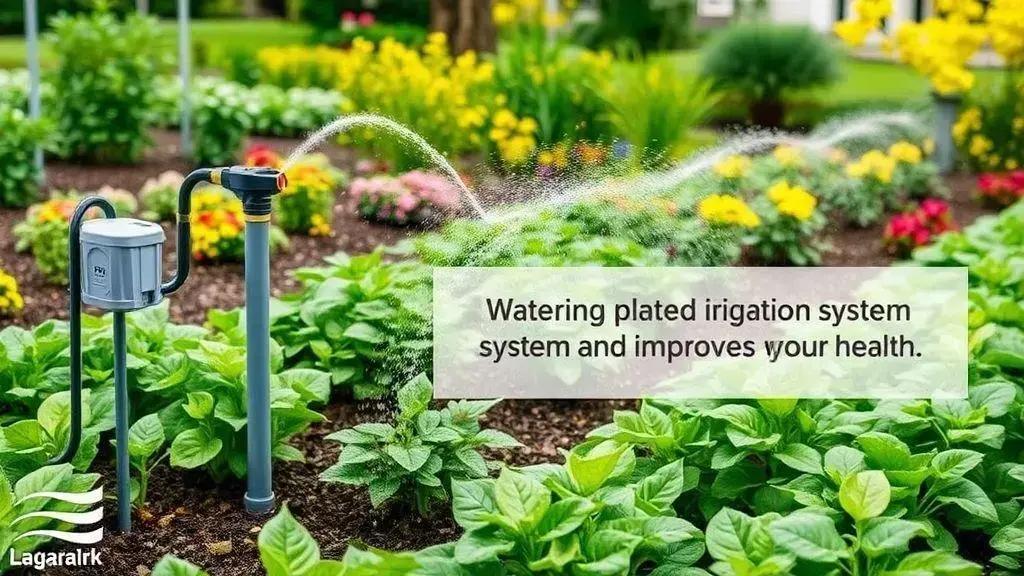Automated irrigation control systems: transform your garden

Automated irrigation control systems enhance plant health and conserve water by regulating watering schedules based on real-time data and moisture levels, preventing overwatering and promoting growth.
Automated irrigation control systems are changing the way we manage water in our gardens and farms. They not only conserve water but also promote healthier plants. Have you ever wondered how these systems can make your gardening easier?
Understanding automated irrigation control systems
Understanding automated irrigation control systems is key to maximizing water efficiency in gardening and agriculture. These systems help manage the watering of plants with precision, ensuring that each plant receives the right amount of water. Imagine having a garden that automatically adjusts its watering schedule based on weather conditions and soil moisture levels!
Components of Automated Irrigation Systems
There are three main components that make up an automated irrigation system: controllers, valves, and sensors. These work together to create a seamless watering experience.
- Controllers: These are the brains of the operation, scheduling when and how much to water based on set parameters.
- Valves: They control the flow of water from your main supply to the individual zones in your garden.
- Sensors: Soil moisture sensors provide real-time data to controllers, ensuring plants only get watered when necessary.
When choosing an automated irrigation control system, it’s crucial to consider the layout of your garden and the types of plants you have. Different plants have different water requirements. For instance, drought-tolerant plants need less frequent watering than those that thrive in wet conditions. By customizing your system according to these needs, you can greatly enhance your garden’s health.
Benefits ofAutomated Systems
One of the primary advantages of using automated systems is their ability to conserve water. Traditional watering methods can lead to overwatering or underwatering, impacting plant health. In contrast, automated systems deliver precise amounts of water based on current conditions.
Additionally, these systems save time and labor. Instead of spending hours watering your garden by hand, you can set up a system that works while you focus on other tasks. The automation allows you to go on vacations without worrying about your plants drying out.
Moreover, many modern irrigation control systems can be connected to smart devices, enabling remote management through apps. This connectivity provides real-time updates and control, ensuring your garden remains healthy no matter where you are.
Benefits of using automated irrigation

The benefits of using automated irrigation systems are profound and numerous. They enhance plant growth while conserving water. By automating your irrigation, you ensure that plants receive just the right amount of water they need to thrive.
Water Conservation
One of the standout advantages is water conservation. Traditional irrigation methods can waste a significant amount of water through evaporation or runoff. Automated systems only activate when necessary, based on real-time data from soil moisture sensors.
- They reduce water waste, promoting sustainability.
- System adjustments can be made based on weather forecasts.
- Water usage can be tracked and optimized over time.
These features help maintain a healthy balance in water usage, essential in areas prone to drought.
Time Efficiency
Automated irrigation systems save you time and energy. Instead of spending hours watering your garden by hand, these systems do the hard work for you. With proper setup, you can simply schedule the watering intervals that fit your needs.
Automation means you can go on vacation, knowing your plants will be cared for. Additionally, modern systems often allow for remote control via smartphone apps, adding convenience to your gardening routine.
Improved Plant Health
When you use automated irrigation, your plants receive adequate hydration consistently. This is crucial for their growth and resilience. Stress caused by over or underwatering can lead to weak, unhealthy plants.
With accurate watering schedules, you create an environment where plants can thrive. Healthy plants are more resistant to pests and diseases, ultimately leading to a better yield in garden produce.
Setting up a smart irrigation system
Setting up a smart irrigation system is easier than you might think. With a few essential components and careful planning, you can automate the watering of your garden efficiently. This not only saves water but also ensures that your plants receive the right amount of moisture.
Choosing the Right System
The first step is to choose the right type of smart irrigation system for your needs. There are various options available, such as drip irrigation, sprinkler systems, and soaker hoses. Each has its own advantages, so consider the layout and plant types in your garden.
- Drip irrigation: Ideal for targeted watering around plants.
- Sprinkler systems: Great for larger areas with a variety of plants.
- Soaker hoses: Efficient for gentle watering of beds and borders.
Once you’ve selected a system, gathering the necessary components becomes the next priority. You will typically need controllers, valves, hoses, and sensors to monitor moisture levels.
Installation Process
The installation of your system begins with planning the layout. Mapping out where each hose or sprinkler will go helps ensure coverage of all plants. After that, you can begin laying down the hoses or installing the sprinklers.
It’s important to connect these elements to a controller that can regulate watering times and durations. Consider using a timer or a smart controller that adjusts operations based on local weather data. This will optimize watering times, preventing over or under-watering.
Integrating Sensors for Efficiency
To make your smart irrigation system even more efficient, integrating soil moisture sensors is key. These sensors provide real-time feedback on soil conditions, allowing the system to water only when necessary. This ensures that plants are not overwatered, promoting healthier growth.
Smart controllers coupled with sensors can learn from past watering schedules and adjust future settings accordingly. This level of automation is beneficial, helping both novice and expert gardeners maintain lush, healthy gardens with minimal effort.
Common mistakes to avoid in irrigation management

Managing irrigation systems effectively is crucial for maintaining a healthy garden. However, there are some common mistakes that can lead to poor plant health and wasted resources. Recognizing these pitfalls can help you optimize your irrigation management and achieve better results.
Overwatering Plants
One of the biggest mistakes gardeners make is overwatering their plants. This can lead to root rot and other fungal diseases, harming your garden. It’s essential to monitor soil moisture and water only when necessary.
- Use moisture sensors to determine when plants need water.
- Check soil moisture levels before watering.
- Avoid watering during rainy days to prevent excess moisture.
By avoiding overwatering, you promote stronger root systems and healthier plants.
Ignoring Weather Conditions
Another common mistake is failing to consider weather conditions. Weather changes can significantly affect your watering needs. For instance, an unexpected rainstorm can make your scheduled watering unnecessary.
To avoid this, ensure your irrigation system has smart technology that adjusts based on real-time weather data. Many modern systems can automatically skip watering if it has rained recently, saving water and reducing costs.
Neglecting Regular Maintenance
Not performing regular maintenance on your irrigation system is a mistake that can lead to costly repairs later on. Clogged filters and broken hoses can waste water and damage plants. Regular checks on your system ensure it operates smoothly.
Make a habit of inspecting your system’s components, including:
- Checking for leaks in hoses and connections.
- Cleaning or replacing filters regularly.
- Testing sprinkler heads to ensure even coverage.
This maintenance will keep your system efficient and your garden thriving.
In conclusion, effective irrigation management is crucial for ensuring the health and vitality of your plants. By avoiding common mistakes such as overwatering, ignoring weather conditions, and neglecting regular system maintenance, you can create a thriving garden.
Implementing a smart irrigation system not only conserves water but also promotes better growth and resilience in your plants. With proper setup and maintenance, your garden can flourish while you enjoy the convenience of automation.
FAQ – Common Questions About Irrigation Management
What is the best way to avoid overwatering my plants?
Using soil moisture sensors can help you monitor when your plants actually need water, preventing overwatering and promoting better plant health.
How can I adjust my irrigation according to weather changes?
Invest in a smart irrigation controller that can automatically adjust watering schedules based on real-time weather data and rainfall predictions.
Why is regular maintenance important for my irrigation system?
Regular maintenance prevents leaks and clogs, ensuring your system operates efficiently and maintains healthy plants.
What type of irrigation system is best for my garden?
The best system depends on your garden’s layout and plant types. Drip irrigation is great for targeted watering, while sprinklers are suitable for larger areas.





